Timeline of the 2017 Pacific hurricane season
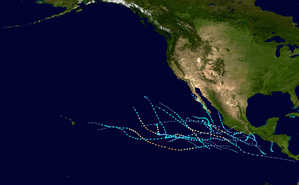
The 2017 Pacific hurricane season was an event in the annual cycle of tropical cyclone formation, in which tropical cyclones form in the eastern Pacific Ocean. The season officially started on May 15 in the eastern Pacific—east of 140°W—and on June 1 in the central Pacific—between the International Date Line and 140°W—and ended on November 30. These dates typically cover the period of each year when most tropical cyclones form in the eastern Pacific basin.[1]
Four time zones are utilized in the basin: Central for storms east of 106°W, Mountain between 114.9°W and 106°W, Pacific between 140°W and 115°W,[2] and Hawaii–Aleutian for storms between the International Date Line and 140°W. However, for convenience, all information is listed by Coordinated Universal Time (UTC) first with the respective local time included in parentheses. This timeline includes information that was not operationally released, meaning that data from post-storm reviews by the National Hurricane Center is included. This timeline documents tropical cyclone formations, strengthening, weakening, landfalls, extratropical transitions, and dissipations during the season.
Timeline of events

May
May 9
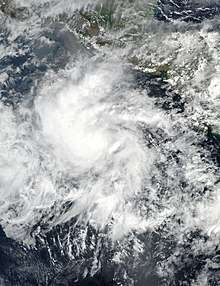
- 18:00 UTC (1:00 p.m. CDT) at 9°18′N 91°12′W / 9.3°N 91.2°W – Tropical Depression One-E develops from an area of low pressure about 315 miles (510 km) south-southwest of the El Salvador–Guatemala border.[3]
May 10
- 00:00 UTC (7:00 p.m. CDT May 9) at 9°30′N 91°42′W / 9.5°N 91.7°W – Tropical Depression One-E intensifies into Tropical Storm Adrian, becoming the earliest named storm in the eastern Pacific basin on record.[3]
- 06:00 UTC (1:00 a.m. CDT) at 9°42′N 92°00′W / 9.7°N 92.0°W – Tropical Storm Adrian reaches peak intensity with winds of 45 mph (75 km/h) and a minimum pressure of 1004 mbar (hPa; 29.65 inHg).[3]
May 11
- 00:00 UTC (7:00 p.m. CDT May 10) at 10°30′N 92°54′W / 10.5°N 92.9°W – Tropical Storm Adrian degenerates to a post-tropical cyclone around 280 miles (455 km) south of the Guatemala–Mexico border.[3]
May 12
- 12:00 UTC (7:00 a.m. CDT) – The remnants of Adrian dissipate 160 miles (260 km) south of Puerto Ángel, Mexico.[3]
May 15
- The 2017 Eastern Pacific hurricane season officially begins.[1]
May 31
- 12:00 UTC (7:00 a.m. CDT) at 13°48′N 97°54′W / 13.8°N 97.9°W – Tropical Depression Two-E develops from an area of low pressure about 175 miles (280 km) southwest of Puerto Ángel, Mexico.[4]
June
June 1
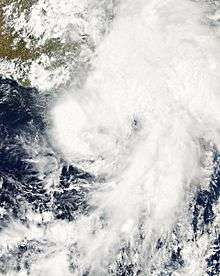
- The 2017 Central Pacific hurricane season officially begins.[1]
- 06:00 UTC (1:00 a.m. CDT) at 14°30′N 97°18′W / 14.5°N 97.3°W – Tropical Depression Two-E intensifies into Tropical Storm Beatriz roughly 105 miles (165 km) southwest of Puerto Ángel, Mexico.[4]
- 12:00 UTC (7:00 a.m. CDT) at 14°48′N 97°06′W / 14.8°N 97.1°W – Tropical Storm Beatriz reaches peak intensity with winds of 45 mph (75 km/h) and a minimum pressure of 1001 mbar (hPa; 29.56 inHg).[4]
June 2
- 00:00 UTC (7:00 p.m. CDT June 1) at 15°42′N 96°36′W / 15.7°N 96.6°W – Tropical Storm Beatriz makes landfall 25 miles (35 km) west of Puerto Ángel, Mexico while still at peak intensity.[4]
- 06:00 UTC (1:00 a.m. CDT) at 16°18′N 96°18′W / 16.3°N 96.3°W – Tropical Storm Beatriz weakens to a tropical depression over southern Mexico.[4]
- 12:00 UTC (7:00 a.m. CDT) – Tropical Depression Beatriz dissipates over the mountains of southern Mexico.[4]
June 11
- 12:00 UTC (7:00 p.m. CDT) at 14°00′N 94°42′W / 14.0°N 94.7°W – Tropical Depression Three-E develops from an area of low pressure about 150 miles (240 km) south-southeast of Salina Cruz, Mexico.[5]
June 12
- 18:00 UTC (1:00 p.m. CDT) at 15°30′N 95°30′W / 15.5°N 95.5°W – Tropical Depression Three-E intensifies into Tropical Storm Calvin about 45 miles (75 km) south-southwest of Salina Cruz, Mexico.[5]

June 13
- 00:00 UTC (7:00 p.m. CDT June 12) at 15°54′N 95°42′W / 15.9°N 95.7°W – Tropical Storm Calvin reaches peak intensity with winds of 45 mph (75 km/h) and a minimum pressure of 1004 mbar (hPa; 29.65 inHg), and simultaneously makes landfall near Paja Blanca, Mexico.[5]
- 06:00 UTC (1:00 a.m. CDT) at 16°12′N 96°06′W / 16.2°N 96.1°W – Tropical Storm Calvin weakens to a tropical depression as it pushes inland.[5]
- 12:00 UTC (7:00 a.m. CDT) – Tropical Depression Calvin completely dissipates over the mountains of southern Mexico.[5]
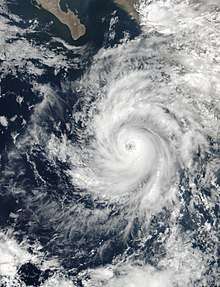
June 24
- 18:00 UTC (1:00 p.m. CDT) at 13°36′N 98°42′W / 13.6°N 98.7°W – Tropical Depression Four-E develops from an area of low pressure about 230 miles (370 km) south-southeast of Acapulco, Mexico.[6]
June 25
- 06:00 UTC (1:00 a.m. CDT June 25) at 14°24′N 100°24′W / 14.4°N 100.4°W – Tropical Depression Four-E intensifies into Tropical Storm Dora.[6]
June 26
- 06:00 UTC (1:00 a.m. CDT) at 16°36′N 104°48′W / 16.6°N 104.8°W – Tropical Storm Dora intensifies into a Category 1 hurricane about 175 miles (280 km) south of Manzanillo, Mexico.[6]
- 12:00 UTC (7:00 a.m. CDT) at 17°06′N 105°48′W / 17.1°N 105.8°W - Hurricane Dora intensifies into a Category 2 hurricane.[6]
- 18:00 UTC (12:00 p.m. MDT) at 17°36′N 106°48′W / 17.6°N 106.8°W – Hurricane Dora attains its peak intensity with maximum sustained winds of 105 mph (165 km/h) and a minimum barometric pressure of 974 mbar (hPa; 28.76 inHg).[6]
June 27
- 06:00 UTC (12:00 a.m. MDT) at 18°36′N 108°42′W / 18.6°N 108.7°W – Hurricane Dora weakens into a Category 1 hurricane.[6]
- 18:00 UTC (12:00 p.m. MDT) at 19°18′N 110°42′W / 19.3°N 110.7°W – Hurricane Dora weakens further into a tropical storm.[6]
June 28
- 06:00 UTC (12:00 a.m. MDT) at 19°42′N 112°36′W / 19.7°N 112.6°W - Tropical Storm Dora degenerates into a post-tropical cyclone about 275 miles (445 km) southwest of the southern tip of the Baja California peninsula.[6]
July
July 1
- 06:00 UTC (11:00 p.m. PDT June 30) – Post-Tropical Cyclone Dora dissipates completely 540 miles (870 km) west-southwest of the southern tip of the Baja California peninsula.[6]
July 7
- 21:00 UTC (3:00 p.m. MDT July 7) at 11°54′N 111°12′W / 11.9°N 111.2°W - Tropical Storm Eugene develops from an area of low pressure about 765 miles (1230 km) south of the southern tip of Baja California.[7]
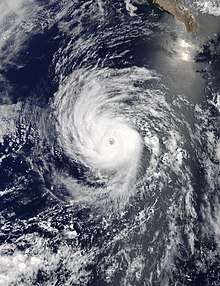
July 8
- 03:00 UTC (9:00 p.m. MDT July 8) at 14°24′N 113°30′W / 14.4°N 113.5°W - Tropical Storm Eugene intensifies into a Category 1 hurricane roughly 630 miles (1020 km) south-southwest of the southern tip of Baja California.[8]
July 9
- 09:00 UTC (3:00 a.m. MDT) at 15°12′N 114°06′W / 15.2°N 114.1°W – Hurricane Eugene rapidly intensifies into a Category 2 hurricane approximately 600 miles (960 km) south-southwest of the southern tip of the Baja California Peninsula.[9]
- 15:00 UTC (9:00 a.m. MDT) at 16°00′N 114°36′W / 16.0°N 114.6°W – Hurricane Eugene rapidly intensifies into a Category 3 hurricane and simultaneously attains its peak intensity with maximum sustained winds of 115 mph (185 km/h) and a minimum barometric pressure of 965 mbar (hPa; 28.50 inHg) about 565 miles (910 km) southwest of the southern tip of the Baja California Peninsula.[10]
July 10
- 03:00 UTC (8:00 p.m. PDT July 9) at 17°36′N 115°54′W / 17.6°N 115.9°W – Hurricane Eugene weakens to a Category 2 hurricane roughly 535 miles (860 km) southwest of the southern tip of the Baja California Peninsula.[11]
- 15:00 UTC (8:00 a.m. PDT) at 18°42′N 117°12′W / 18.7°N 117.2°W – Hurricane Eugene weakens to a Category 1 hurricane approximately 640 miles (1,035 km) south-southwest of Punta Eugenia, Mexico.[12]
July 11
- 03:00 UTC (8:00 p.m. PDT July 10) at 20°12′N 118°12′W / 20.2°N 118.2°W – Hurricane Eugene weakens to a tropical storm about 560 miles (900 km) south-southwest of Punta Eugenia, Mexico.[13]
July 12
- 03:00 UTC (9:00 p.m. MDT July 11) at 12°12′N 109°54′W / 12.2°N 109.9°W – Tropical Depression Six-E develops from an area of low pressure about 740 miles (1,190 km) south of the southern tip of the Baja California Peninsula.[14]
- 15:00 UTC (8:00 a.m. PDT) at 23°36′N 121°48′W / 23.6°N 121.8°W – Tropical Storm Eugene weakens to a tropical depression roughly 510 miles (815 km) west-southwest of Punta Eugenia, Mexico.[15]
- 15:00 UTC (9:00 a.m. MDT) at 12°00′N 111°30′W / 12.0°N 111.5°W – Tropical Depression Six-E intensifies into Tropical Storm Fernanda about 760 miles (1,225 km) south of the southern tip of the Baja California Peninsula.[16]
- 21:00 UTC (2:00 p.m. PDT) at 24°06′N 122°30′W / 24.1°N 122.5°W – Tropical Depression Eugene degenerates to a remnant low approximately 525 miles (845 km) west-southwest of Punta Eugenia, Mexico.[17]
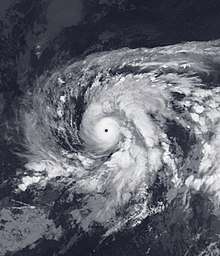
July 13
- 21:00 UTC (2:00 p.m. PDT) at 11°12′N 116°00′W / 11.2°N 116.0°W – Tropical Storm Fernanda intensifies into a Category 1 hurricane about 900 miles (1,450 km) south-southwest of the southern tip of the Baja California Peninsula.[18]
July 14
- 09:00 UTC (2:00 a.m. PDT) at 11°00′N 117°54′W / 11.0°N 117.9°W – Hurricane Fernanda rapidly intensifies into a Category 2 hurricane roughly 975 miles (1,570 km) southwest of the southern tip of the Baja California Peninsula.[19]
- 15:00 UTC (8:00 a.m. PDT) at 10°54′N 118°54′W / 10.9°N 118.9°W – Hurricane Fernanda rapidly intensifies into a Category 3 hurricane approximately 1,020 miles (1,640 km) southwest of the southern tip of the Baja California Peninsula.[20]
- 21:00 UTC (2:00 p.m. PDT) at 10°42′N 119°42′W / 10.7°N 119.7°W – Hurricane Fernanda rapidly intensifies into a Category 4 hurricane, the second strongest hurricane so far south in the eastern Pacific, about 1,060 miles (1,710 km) southwest of the southern tip of the Baja California Peninsula.[21][22]
July 15
- 03:00 UTC (8:00 p.m. PDT July 14) at 10°42′N 120°48′W / 10.7°N 120.8°W – Hurricane Fernanda attains its peak intensity with maximum sustained winds of 145 mph (230 km/h) and a minimum barometric pressure of 947 mbar (hPa; 27.97 inHg) roughly 1,105 miles (1,780 km) southwest of the southern tip of the Baja California Peninsula. [23]
July 16
- 03:00 UTC (8:00 p.m. PDT July 15) at 11°42′N 125°24′W / 11.7°N 125.4°W – Hurricane Fernanda weakens to a Category 3 hurricane approximately 1,280 miles (2,060 km) southwest of the southern tip of the Baja California Peninsula.[24]
- 09:00 UTC (2:00 a.m. PDT) at 12°06′N 126°12′W / 12.1°N 126.2°W – Hurricane Fernanda re-intensifies into a Category 4 hurricane about 1,305 miles (2,100 km) west-southwest of the southern tip of the Baja California Peninsula.[25]
- 21:00 UTC (2:00 p.m. PDT) at 12°42′N 128°24′W / 12.7°N 128.4°W – Hurricane Fernanda weakens to a Category 3 hurricane for a second time roughly 1,405 miles (2,260 km) west-southwest of the southern tip of the Baja California Peninsula.[26]
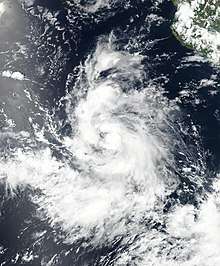
July 17
- 15:00 UTC (10:00 a.m. CDT) at 14°06′N 105°06′W / 14.1°N 105.1°W – Tropical Depression Seven-E develops from an area of low pressure approximately 340 miles (550 km) south of Manzanillo, Colima.[27]
July 18
- 03:00 UTC (8:00 p.m. PDT July 17) at 14°42′N 132°12′W / 14.7°N 132.2°W – Hurricane Fernanda weakens to a Category 2 hurricane roughly 1,560 miles (2,515 km) west-southwest of the southern tip of the Baja California Peninsula.[28]
- 09:00 UTC (3:00 a.m. MDT) at 14°36′N 107°36′W / 14.6°N 107.6°W – Tropical Depression Seven-E intensifies into Tropical Storm Greg about 375 miles (600 km) southwest of Manzanillo, Colima.[29]
- 15:00 UTC (8:00 a.m. PDT) at 14°36′N 118°48′W / 14.6°N 118.8°W – Tropical Depression Eight-E develops from an area of low pressure approximately 815 miles (1,315 km) southwest of the southern tip of the Baja California Peninsula.[30]
July 19
- 09:00 UTC (2:00 a.m. PDT) at 17°00′N 135°00′W / 17.0°N 135.0°W – Hurricane Fernanda weakens to a Category 1 hurricane roughly 1,330 miles (2,140 km) east of Hilo, Hawaii.[31]
July 20
- 09:00 UTC (2:00 a.m. PDT) at 18°12′N 137°42′W / 18.2°N 137.7°W - Hurricane Fernanda weakens to a tropical storm roughly 1,140 miles (1,835 km) east of Hilo, Hawaii.[32]
- 21:00 UTC (2:00 p.m. PDT) at 13°18′N 123°54′W / 13.3°N 123.9°W - Tropical Depression Eight-E degenerates to a remnant area of low pressure roughly 1130 miles (1820 km) west-southwest of the southern tip of the Baja California Peninsula.[33]
July 21
- 15:00 UTC (8:00 a.m. PDT) at 15°06′N 119°12′W / 15.1°N 119.2°W – Tropical Storm Greg attains peak winds of 60 mph (95 km/h) while located 810 miles (1,305 km) southwest of the southern tip of the Baja California Peninsula.[34]
- 15:00 UTC (10:00 a.m. CDT) at 9°00′N 93°30′W / 9.0°N 93.5°W – Tropical Depression Nine-E develops from an area of low pressure approximately 505 miles (815 km) south-southeast of Puerto Ángel, Oaxaca.[35]
July 22
- 03:00 UTC (5:00 p.m. HST) at 19°00′N 144°48′W / 19.0°N 144.8°W – Tropical Storm Fernanda weakens to a tropical depression about 675 miles (1,085 km) east of Hilo, Hawaii.[36]
- 15:00 UTC (9:00 a.m. MDT) at 14°42′N 112°48′W / 14.7°N 112.8°W – Tropical Depression Ten-E develops from an area of low pressure approximately 595 miles (960 km) south-southwest of the southern tip of the Baja California Peninsula.[37]
- 21:00 UTC (11:00 a.m. HST) at 19°30′N 147°24′W / 19.5°N 147.4°W – Tropical Depression Fernanda degenerates to a remnant area of low pressure roughly 500 miles (805 km) east of Hilo, Hawaii.[38]
July 23
- 03:00 UTC (10:00 p.m. CDT July 22) at 11°30′N 110°12′W / 11.5°N 110.2°W – Tropical Depression Nine-E intensifies into Tropical Storm Hilary about 585 miles (940 km) south-southeast of Manzanillo, Colima.[39]
- 09:00 UTC (2:00 a.m. PDT) at 14°42′N 115°12′W / 14.7°N 115.2°W – Tropical Depression Ten-E intensifies into Tropical Storm Irwin roughly 665 miles (1,070 km) south-southwest of the southern tip of the Baja California Peninsula.[40]
July 24
- 09:00 UTC (4:00 a.m. CDT) at 14°00′N 103°48′W / 14.0°N 103.8°W – Tropical Storm Hilary intensifies into a Category 1 hurricane about 345 miles (560 km) south of Manzanillo, Colima.[41]
July 25
- 03:00 UTC (10:00 p.m. CDT July 24) at 15°00′N 105°42′W / 15.0°N 105.7°W – Hurricane Hilary intensifies into a Category 2 hurricane approximately 290 miles (470 km) south-southwest of Manzanillo, Colima.[42]
- 09:00 UTC (2:00 a.m. PDT) at 15°30′N 118°42′W / 15.5°N 118.7°W – Tropical Storm Irwin strengthens into a Category 1 hurricane roughly 770 miles (1,235 km) southwest of the southern tip of the Baja California Peninsula.[43]
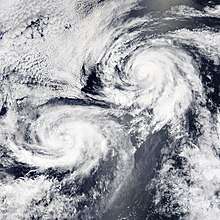
July 26
- 03:00 UTC (8:00 p.m. PDT July 25) at 16°06′N 120°54′W / 16.1°N 120.9°W – Hurricane Irwin peaks as a strong Category 1 hurricane with winds of 90 mph (150 km/h) and a central pressure of 980 mbar (hPa; 28.94 inHg) approximately 855 miles (1,375 km) west-southwest of the southern tip of the Baja California Peninsula.[44]
- 15:00 UTC (8:00 a.m. PDT) at 15°36′N 122°06′W / 15.6°N 122.1°W – Hurricane Irwin weakens to a tropical storm roughly 940 miles (1,515 km) west-southwest of the southern tip of the Baja California Peninsula.[45]
- 21:00 UTC (3:00 p.m. MDT) at 16°42′N 113°12′W / 16.7°N 113.2°W – Hurricane Hilary reaches its peak intensity with winds of 105 mph (165 km/h) and a minimum pressure of 972 mbar (hPa; 28.71 inHg) while located about 480 miles (770 km) south-southwest of the southern tip of the Baja California Peninsula.[46]
July 27
- 09:00 UTC (2:00 a.m. PDT) at 17°18′N 115°06′W / 17.3°N 115.1°W – Hurricane Hilary weakens back to a Category 1 hurricane around 515 miles (825 km) southwest of the southern tip of the Baja California Peninsula.[47]
July 28
- 03:00 UTC (8:00 p.m. PDT July 27) at 18°18′N 117°18′W / 18.3°N 117.3°W – Hurricane Hilary further weakens to a tropical storm about 575 miles (925 km) west-southwest of the southern tip of the Baja California Peninsula.[48]
July 31
- 03:00 UTC (8:00 p.m. PDT July 30) at 25°36′N 128°30′W / 25.6°N 128.5°W – Tropical Storm Hilary degenerates to a post-tropical cyclone about 1,185 miles (1,905 km) west-northwest of the southern tip of the Baja California Peninsula.[49]
August
August 1
- 15:00 UTC (8:00 a.m. PDT) at 25°54′N 129°12′W / 25.9°N 129.2°W – Tropical Storm Irwin degrades to a tropical depression roughly 1,230 miles (1,980 km) west-northwest of the southern tip of the Baja California Peninsula.[50]
- 21:00 UTC (2:00 p.m. PDT) at 26°36′N 129°42′W / 26.6°N 129.7°W – Tropical Depression Irwin weakens to a post-tropical cyclone approximately 1,265 miles (2,040 km) west-northwest of the southern tip of the Baja California Peninsula.[51]
August 4
- 15:00 UTC (9:00 a.m. MDT) at 17°42′N 109°12′W / 17.7°N 109.2°W – Tropical Depression Eleven-E forms about 335 miles (535 km) west-southwestof Manzanillo, Mexico.[52]
August 5
- 21:00 UTC (3:00 p.m. MDT) at 20°18′N 111°42′W / 20.3°N 111.7°W – Tropical Depression Eleven-E becomes a remnant low roughly 115 miles (180 km) north-northwest of Socorro Island.[53]
August 11
- 03:00 UTC (9:00 p.m. MDT August 10) at 19°18′N 109°48′W / 19.3°N 109.8°W – Tropical Storm Jova forms and reaches peak intensity of maximum sustained winds of 40 mph (65 km/h) and a minimum barometric pressure of 1003 mbar (hPa; 29.62 inHg) about 250 miles (400 km) south of the southern tip of Baja California.[54]
August 12
- 21:00 UTC (3:00 p.m. MDT) at 20°24′N 113°06′W / 20.4°N 113.1°W – Tropical Storm Jova weakens into a tropical depression roughly 175 miles (285 km) northwest of Socorro Island.[55]
August 13
- 03:00 UTC (8:00 p.m. PDT August 12) at 20°30′N 119°42′W / 20.5°N 119.7°W – Tropical Depression Jova transitions into a remnant low roughly 650 miles (1,045 km) west-southwest of the southern tip of Baja California.[56]
August 18
- 15:00 UTC (8:00 a.m. PDT) at 14°48′N 116°30′W / 14.8°N 116.5°W – Tropical Depression Thirteen-E forms about 705 miles (1,135 km) southwest of the southern tip of Baja California.[57]
August 19
- 03:00 UTC (8:00 p.m. PDT August 18) at 15°00′N 119°06′W / 15.0°N 119.1°W – Tropical Depression Thirteen-E intensifies into Tropical Storm Kenneth about 810 miles (1,305 km) southwest of the southern tip of Baja California.[58]
August 20
- 15:00 UTC (8:00 a.m. PDT) at 16°18′N 127°24′W / 16.3°N 127.4°W - Tropical Storm Kenneth intensifies into a Category 1 hurricane about 1,225 miles (1,970 km) west-southwest of the southern tip of Baja California.[59]
August 21
- 03:00 UTC (8:00 p.m. PDT August 20) at 16°48′N 129°06′W / 16.8°N 129.1°W - Tropical Storm Kenneth intensifies into a Category 3 hurricane about 1,315 miles (2,115 km) west-southwest of the southern tip of Baja California.[60]
November
November 30
- The 2017 Pacific hurricane season officially ends.[1]
See also
References
- 1 2 3 4 Christopher W. Landsea; Neal Dorst; Erica Rule (June 2, 2011). "G: Tropical Cyclone Climatology". Hurricane Research Division: Frequently Asked Questions. Atlantic Oceanographic and Meteorological Laboratory. National Oceanic and Atmospheric Administration. G1) When is hurricane season ?. Retrieved April 21, 2017.
- ↑ Robbie J. Berg (May 28, 2015). Tropical Depression One-E Discussion Number 1 (Report). Miami, Florida: National Hurricane Center. Retrieved June 17, 2017.
- 1 2 3 4 5 Michael J. Brennan (November 22, 2017). Tropical Cyclone Report: Tropical Storm Adrian (PDF) (Report). National Hurricane Center. Retrieved September 1, 2018.
- 1 2 3 4 5 6 Daniel P. Brown (July 13, 2017). Tropical Cyclone Report: Tropical Storm Beatriz (PDF) (Report). National Hurricane Center. Retrieved September 1, 2018.
- 1 2 3 4 5 John P. Cangialosi (June 19, 2018). Tropical Cyclone Report: Tropical Storm Calvin (PDF) (Report). National Hurricane Center. Retrieved September 1, 2018.
- 1 2 3 4 5 6 7 8 9 Robbie J. Berg (November 20, 2017). Tropical Cyclone Report: Hurricane Dora (PDF) (Report). National Hurricane Center. Retrieved September 1, 2018.
- ↑ David P. Roberts (July 7, 2017). Tropical Storm Eugene Public Advisory Number 1 (Report). Miami, Florida: National Hurricane Center. Retrieved July 8, 2017.
- ↑ Jack L. Beven II (July 8, 2017). Hurricane Eugene Public Advisory Number 6 (Report). Miami, Florida: National Hurricane Center. Retrieved July 8, 2017.
- ↑ Robbie J. Berg (July 9, 2017). Hurricane Eugene Public Advisory Number 7 (Report). Miami, Florida: National Hurricane Center. Retrieved July 9, 2017.
- ↑ Christopher W. Landsea (July 9, 2017). Hurricane Eugene Public Advisory Number 8 (Report). Miami, Florida: National Hurricane Center. Retrieved July 9, 2017.
- ↑ John P. Cangialosi (July 9, 2017). Hurricane Eugene Public Advisory Number 10 (Report). Miami, Florida: National Hurricane Center. Retrieved July 9, 2017.
- ↑ Christopher W. Landsea (July 10, 2017). Hurricane Eugene Public Advisory Number 12 (Report). Miami, Florida: National Hurricane Center. Retrieved July 10, 2017.
- ↑ Richard J. Pasch (July 10, 2017). Tropical Storm Eugene Public Advisory Number 14 (Report). Miami, Florida: National Hurricane Center. Retrieved July 10, 2017.
- ↑ Daniel P. Brown (July 11, 2017). Tropical Depression Six-E Public Advisory Number 1 (Report). Miami, Florida: National Hurricane Center. Retrieved July 11, 2017.
- ↑ Christopher W. Landsea (July 12, 2017). Tropical Depression Eugene Public Advisory Number 20 (Report). Miami, Florida: National Hurricane Center. Retrieved July 12, 2017.
- ↑ Jack L. Beven II (July 12, 2017). Tropical Storm Fernanda Public Advisory Number 3 (Report). Miami, Florida: National Hurricane Center. Retrieved July 12, 2017.
- ↑ Christopher W. Landsea (July 12, 2017). Post-Tropical Cyclone Eugene Public Advisory Number 21 (Report). Miami, Florida: National Hurricane Center. Retrieved July 12, 2017.
- ↑ Jack L. Beven II (July 13, 2017). Hurricane Fernanda Public Advisory Number 8 (Report). Miami, Florida: National Hurricane Center. Retrieved July 13, 2017.
- ↑ Lixion A. Avila (July 14, 2017). Hurricane Fernanda Public Advisory Number 10 (Report). Miami, Florida: National Hurricane Center. Retrieved July 14, 2017.
- ↑ David A. Zelinsky (July 14, 2017). Hurricane Fernanda Public Advisory Number 11 (Report). Miami, Florida: National Hurricane Center. Retrieved July 14, 2017.
- ↑ Richard J. Pasch (July 14, 2017). Hurricane Fernanda Public Advisory Number 12 (Report). Miami, Florida: National Hurricane Center. Retrieved July 14, 2017.
- ↑ NHC E. Pacific Ops (July 14, 2017). "Fernanda is now a category 4 hurricane- the 2nd strongest storm so far south in the eastern Pacific..." Twitter. Retrieved July 15, 2017.
- ↑ Jack L. Beven II (July 14, 2017). Hurricane Fernanda Public Advisory Number 13 (Report). Miami, Florida: National Hurricane Center. Retrieved July 15, 2017.
- ↑ Jack L. Beven II (July 15, 2017). Hurricane Fernanda Public Advisory Number 17 (Report). Miami, Florida: National Hurricane Center. Retrieved July 15, 2017.
- ↑ Stacy R. Stewart (July 16, 2017). Hurricane Fernanda Public Advisory Number 18 (Report). Miami, Florida: National Hurricane Center. Retrieved July 16, 2017.
- ↑ John P. Cangialosi (July 16, 2017). Hurricane Fernanda Public Advisory Number 20 (Report). Miami, Florida: National Hurricane Center. Retrieved July 16, 2017.
- ↑ Daniel P. Brown (July 17, 2017). Tropical Depression Seven-E Public Advisory Number 1 (Report). Miami, Florida: National Hurricane Center. Retrieved July 17, 2017.
- ↑ David P. Roberts (July 18, 2017). Hurricane Fernanda Public Advisory Number 25 (Report). Miami, Florida: National Hurricane Center. Retrieved July 18, 2017.
- ↑ John P. Cangialosi (July 18, 2017). Tropical Storm Greg Public Advisory Number 4 (Report). Miami, Florida: National Hurricane Center. Retrieved July 18, 2017.
- ↑ Daniel P. Brown (July 18, 2017). Tropical Depression Eight-E Public Advisory Number 1 (Report). Miami, Florida: National Hurricane Center. Retrieved July 19, 2017.
- ↑ Stacy R. Stewart (July 19, 2017). Hurricane Fernanda Public Advisory Number 30 (Report). Miami, Florida: National Hurricane Center. Retrieved July 19, 2017.
- ↑ Stacy R. Stewart (July 20, 2017). Tropical Storm Fernanda Public Advisory Number 34 (Report). Miami, Florida: National Hurricane Center. Retrieved July 20, 2017.
- ↑ Jack Beven (July 20, 2017). Post-Tropical Cyclone Eight-E Public Advisory Number 10 (Report). Miami, Florida: National Hurricane Center. Retrieved July 20, 2017.
- ↑ Eric S. Blake (July 21, 2017). Tropical Storm Greg Public Advisory Number 17 (Report). Miami, Florida: National Hurricane Center. Retrieved July 24, 2017.
- ↑ Lixion A. Avila (July 21, 2017). Tropical Depression Nine-E Public Advisory Number 1 (Report). Miami, Florida: National Hurricane Center. Retrieved July 23, 2017.
- ↑ Jeff Powell (July 21, 2017). Tropical Storm Fernanda Public Advisory Number 41 (Report). Honolulu, Hawaii: Central Pacific Hurricane Center. Retrieved July 23, 2017.
- ↑ Lixion A. Avila (July 22, 2017). Tropical Depression Ten-E Public Advisory Number 1 (Report). Miami, Florida: National Hurricane Center. Retrieved July 23, 2017.
- ↑ Tom Birchard (July 22, 2017). Post-Tropical Cyclone Fernanda Public Advisory Number 44 (Report). Honolulu, Hawaii: Central Pacific Hurricane Center. Retrieved July 23, 2017.
- ↑ Jack L. Beven II (July 22, 2017). Tropical Storm Hilary Public Advisory Number 7 (Report). Miami, Florida: National Hurricane Center. Retrieved July 23, 2017.
- ↑ David A. Zelinsky (July 23, 2017). Tropical Storm Irwin Public Advisory Number 4 (Report). Miami, Florida: National Hurricane Center. Retrieved July 23, 2017.
- ↑ Richard J. Pasch (July 24, 2017). Hurricane Hilary Public Advisory Number 12 (Report). Miami, Florida: National Hurricane Center. Retrieved July 24, 2017.
- ↑ Stacy R. Stewart (July 24, 2017). Hurricane Hilary Public Advisory Number 15 (Report). Miami, Florida: National Hurricane Center. Retrieved July 24, 2017.
- ↑ Jack L. Beven II (July 25, 2017). Hurricane Irwin Public Advisory Number 12 (Report). Miami, Florida: National Hurricane Center. Retrieved July 25, 2017.
- ↑ John P. Cangialosi (July 25, 2017). Hurricane Irwin Public Advisory Number 15 (Report). Miami, Florida: National Hurricane Center. Retrieved August 2, 2017.
- ↑ Lixion A. Avila (July 26, 2017). Tropical Storm Irwin Public Advisory Number 17 (Report). Miami, Florida: National Hurricane Center. Retrieved August 2, 2017.
- ↑ Eric S. Blake (July 26, 2017). Hurricane Hilary Public Advisory Number 22 (Report). Miami, Florida: National Hurricane Center. Retrieved August 2, 2017.
- ↑ Jack L. Beven II (July 27, 2017). Hurricane Hilary Public Advisory Number 24 (Report). Miami, Florida: National Hurricane Center. Retrieved August 2, 2017.
- ↑ John P. Cangialosi (July 27, 2017). Tropical Storm Hilary Public Advisory Number 27 (Report). Miami, Florida: National Hurricane Center. Retrieved August 2, 2017.
- ↑ Eric S. Blake (July 30, 2017). Post-Tropical Cyclone Hilary Public Advisory Number 39 (Report). Miami, Florida: National Hurricane Center. Retrieved August 2, 2017.
- ↑ Lixion A. Avila (August 1, 2017). Tropical Depression Irwin Public Advisory Number 41 (Report). Miami, Florida: National Hurricane Center. Retrieved August 2, 2017.
- ↑ Lixion A. Avila (August 1, 2017). Post-Tropical Cyclone Irwin Public Advisory Number 42 (Report). Miami, Florida: National Hurricane Center. Retrieved August 2, 2017.
- ↑ David Zelinsky (August 4, 2017). Tropical Depression Eleven-E Public Advisory Number 1 (Report). Miami, Florida: National Hurricane Center. Retrieved August 31, 2017.
- ↑ David Zelinsky (August 5, 2017). Post-Tropical Cyclone Eleven-E Public Advisory Number 6 (Report). Miami, Florida: National Hurricane Center. Retrieved August 31, 2017.
- ↑ Eric Blake (August 1, 2017). Tropical Storm Jova Public Advisory Number 1 (Report). Miami, Florida: National Hurricane Center. Retrieved August 31, 2017.
- ↑ David Zelinsky (August 12, 2017). Tropical Depression Jova Public Advisory Number 4 (Report). Miami, Florida: National Hurricane Center. Retrieved August 31, 2017.
- ↑ Richard Pasch (August 13, 2017). Post-Tropical Cyclone Jova Public Advisory Number 9 (Report). Miami, Florida: National Hurricane Center. Retrieved August 31, 2017.
- ↑ David Zelinsky (August 18, 2017). Tropical Depression Thirteen-E Public Advisory Number 1 (Report). Miami, Florida: National Hurricane Center. Retrieved August 31, 2017.
- ↑ Roberts, Dave (August 18, 2017). Tropical Storm Kenneth Advisory Number 3 (Report). Miami, Florida: National Hurricane Center. Retrieved September 18, 2017.
- ↑ Cangialosi, John (August 19, 2017). Hurricane Kenneth Advisory Number 9 (Report). Miami, Florida: National Hurricane Center. Retrieved August 31, 2017.
- ↑ Christopher Landsea (August 21, 2017). Hurricane Kenneth Advisory Number 9 (Report). Miami, Florida: National Hurricane Center. Retrieved July 13, 2018.
External links
| Wikimedia Commons has media related to 2017 Pacific hurricane season. |
- The National Hurricane Center's 2017 Tropical Cyclone Advisory Archive
- The Central Pacific Hurricane Center's Tropical Cyclone Advisory Archive
| Preceded by 2016 |
Pacific hurricane season timelines 2017 |
Succeeded by 2018 |